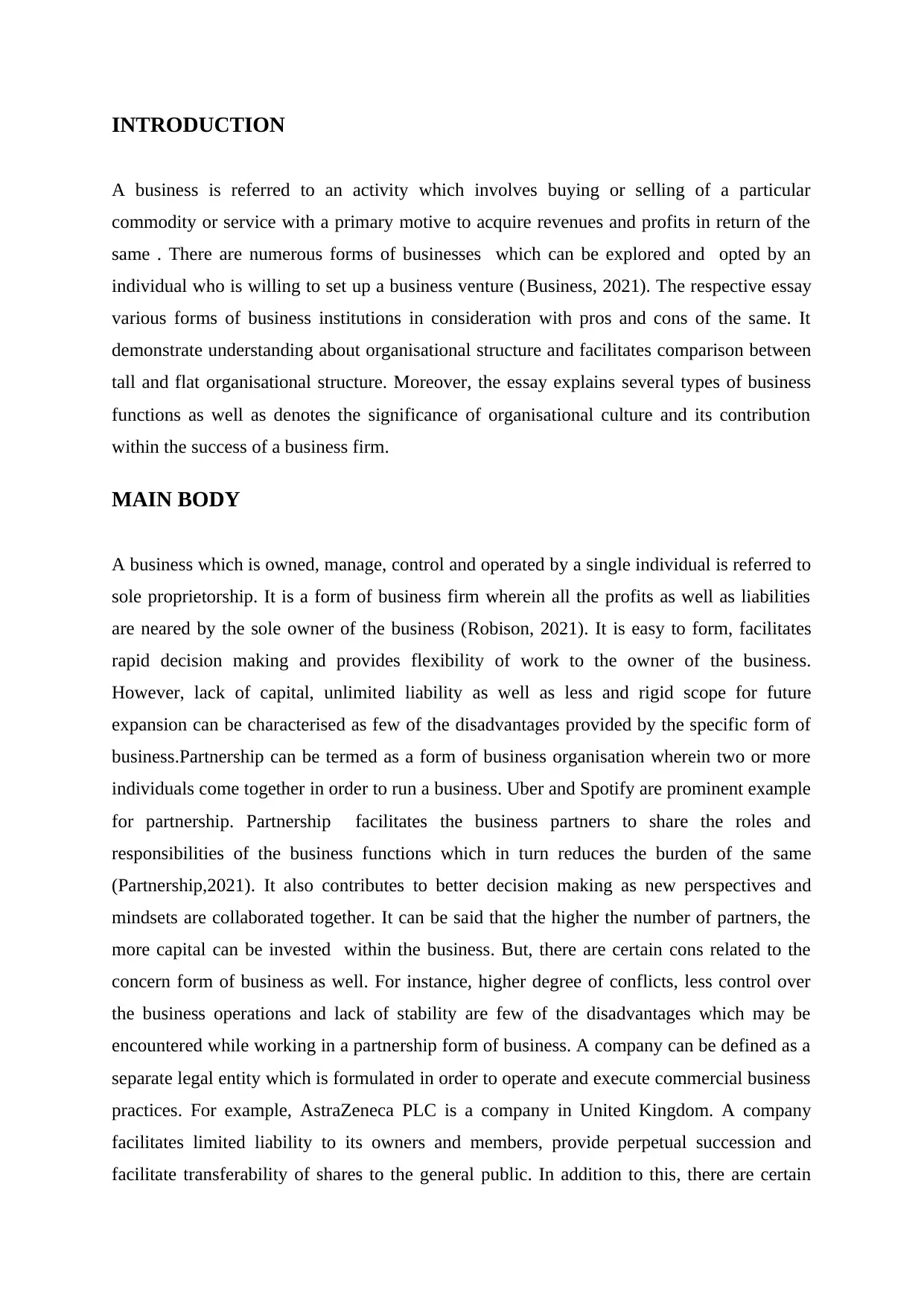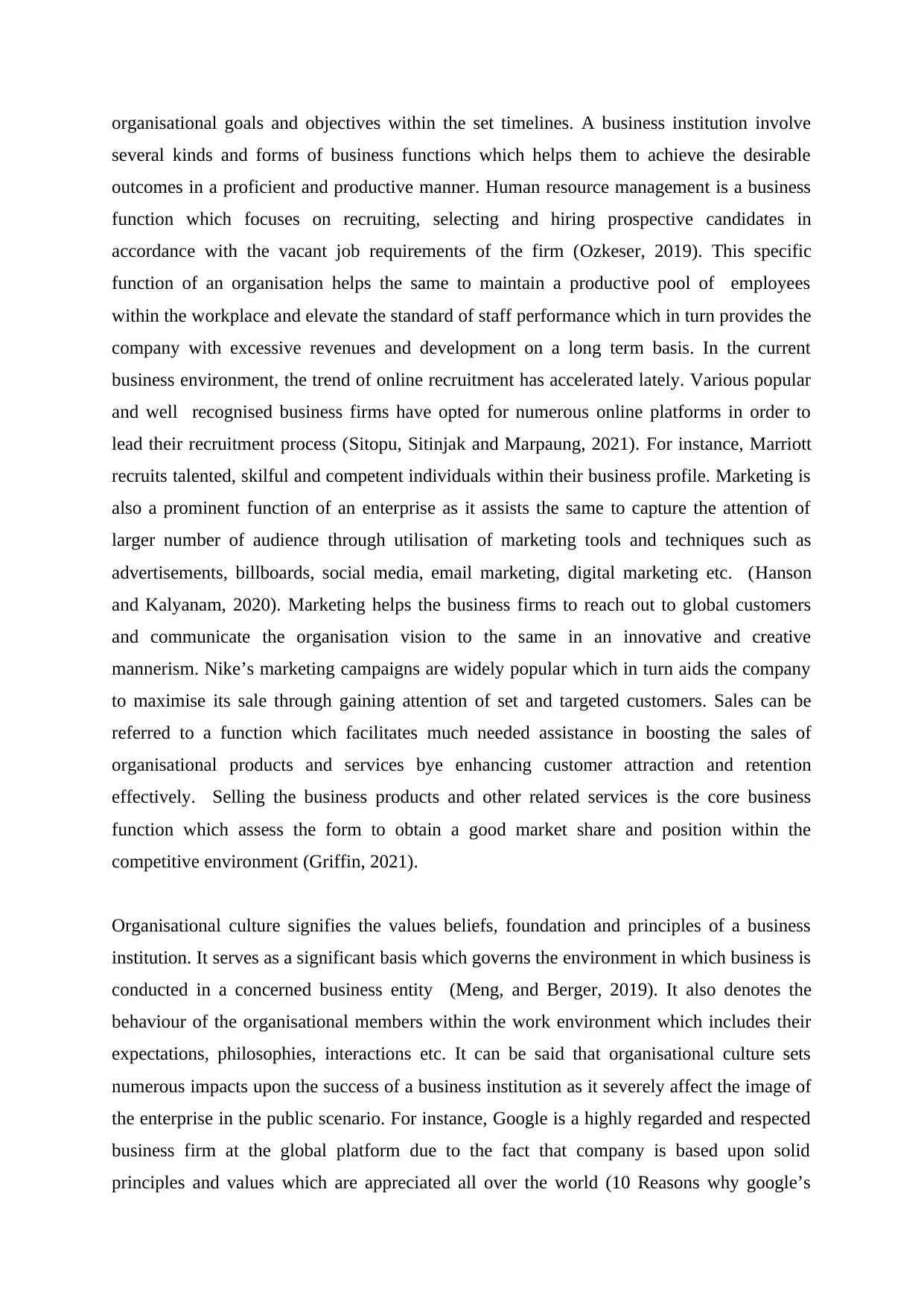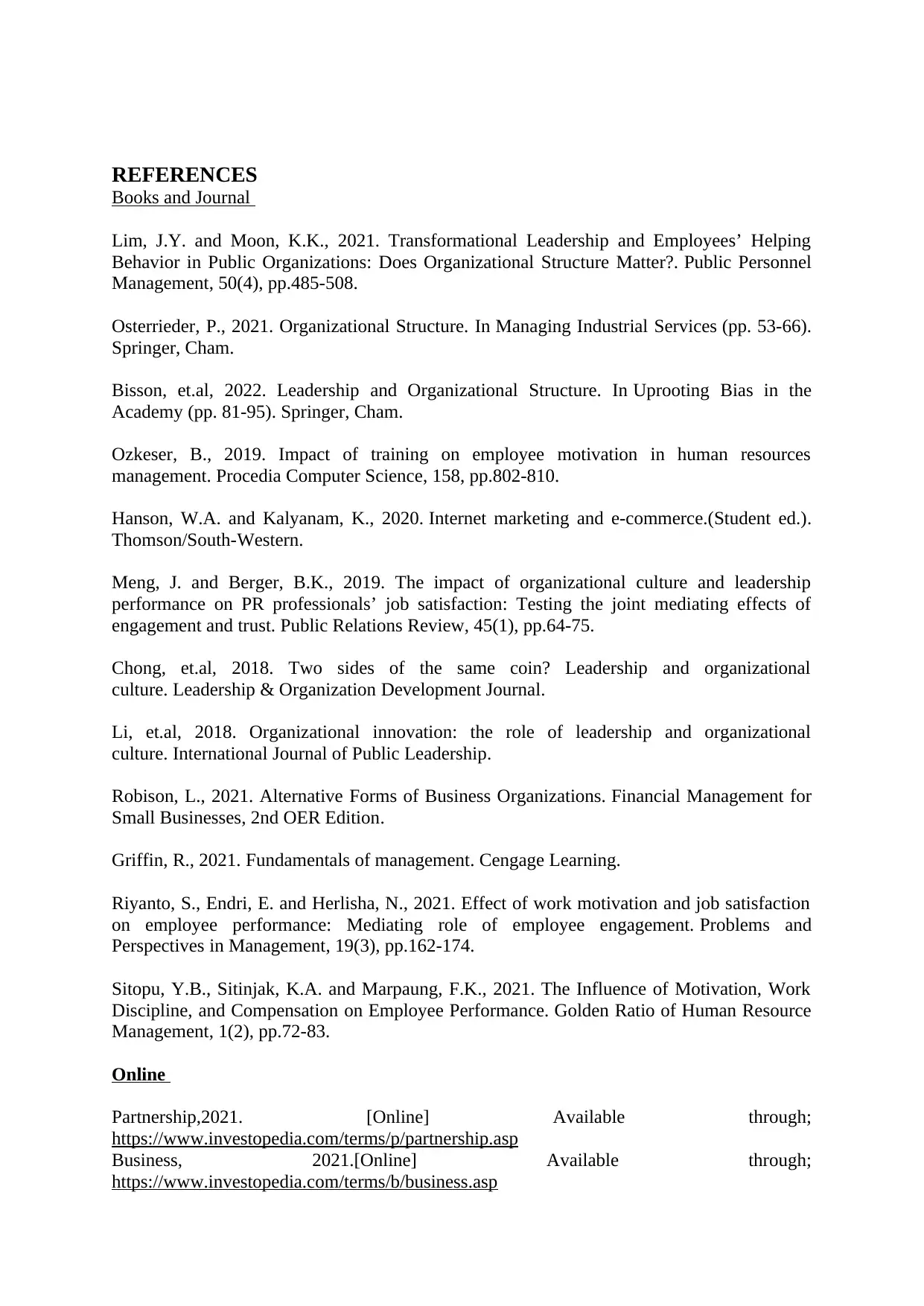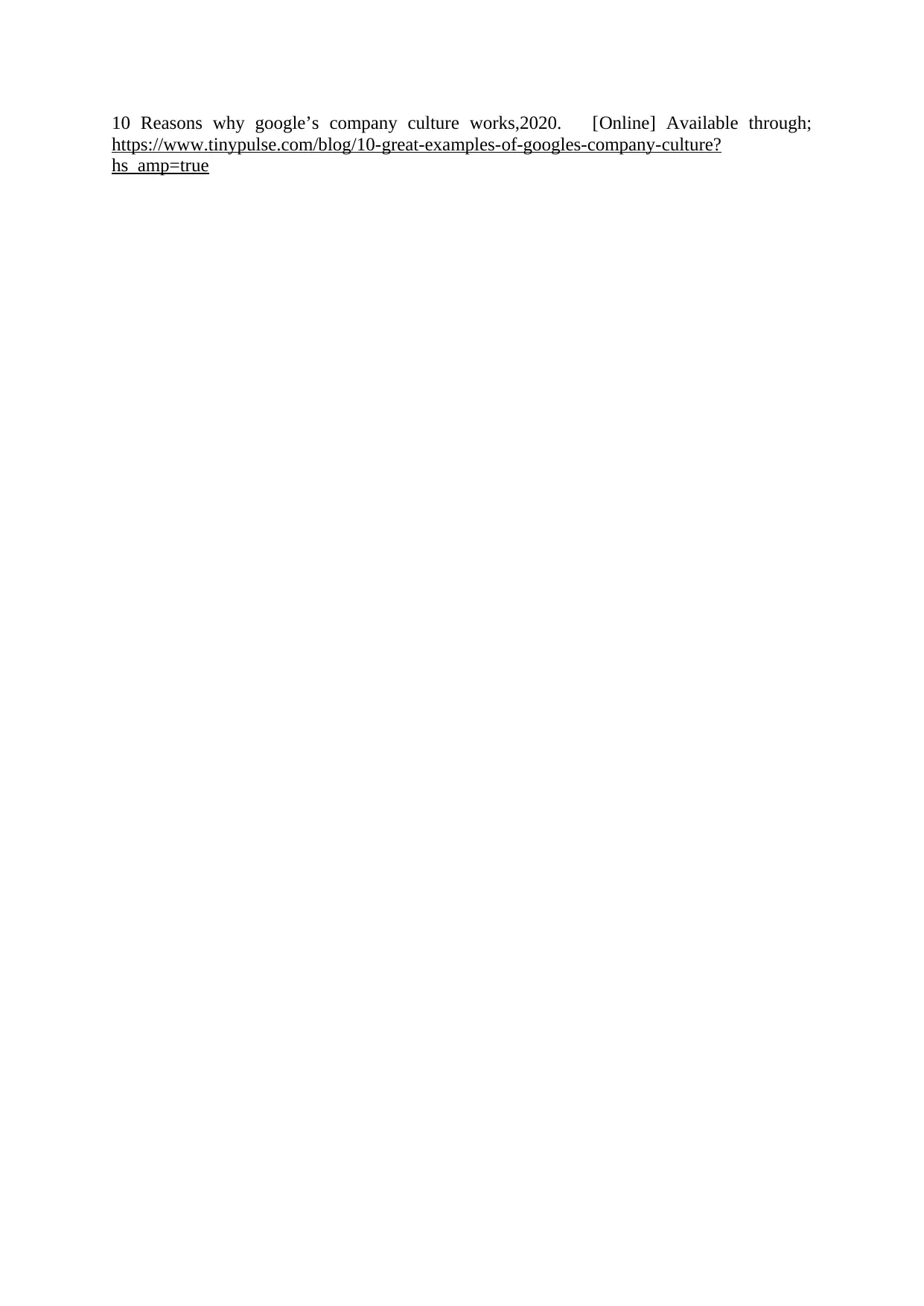Business Organisations: Exploring Forms, Structures, and Functions
VerifiedAdded on 2023/06/14
|7
|2118
|472
Essay
AI Summary
This essay provides a comprehensive analysis of business organizations, exploring various forms such as sole proprietorships, partnerships, and companies, highlighting their respective advantages and disadvantages. It delves into organizational structures, comparing tall and flat hierarchies, and examines key business functions including human resource management, marketing, and sales. The essay also emphasizes the significance of organizational culture in fostering employee engagement, promoting collaboration, and ultimately contributing to the success and reputation of a business. It concludes that understanding and effectively managing these elements are crucial for achieving organizational stability, growth, and a positive work environment.

Understanding Business
Organisation
Organisation
Paraphrase This Document
Need a fresh take? Get an instant paraphrase of this document with our AI Paraphraser

INTRODUCTION
A business is referred to an activity which involves buying or selling of a particular
commodity or service with a primary motive to acquire revenues and profits in return of the
same . There are numerous forms of businesses which can be explored and opted by an
individual who is willing to set up a business venture (Business, 2021). The respective essay
various forms of business institutions in consideration with pros and cons of the same. It
demonstrate understanding about organisational structure and facilitates comparison between
tall and flat organisational structure. Moreover, the essay explains several types of business
functions as well as denotes the significance of organisational culture and its contribution
within the success of a business firm.
MAIN BODY
A business which is owned, manage, control and operated by a single individual is referred to
sole proprietorship. It is a form of business firm wherein all the profits as well as liabilities
are neared by the sole owner of the business (Robison, 2021). It is easy to form, facilitates
rapid decision making and provides flexibility of work to the owner of the business.
However, lack of capital, unlimited liability as well as less and rigid scope for future
expansion can be characterised as few of the disadvantages provided by the specific form of
business.Partnership can be termed as a form of business organisation wherein two or more
individuals come together in order to run a business. Uber and Spotify are prominent example
for partnership. Partnership facilitates the business partners to share the roles and
responsibilities of the business functions which in turn reduces the burden of the same
(Partnership,2021). It also contributes to better decision making as new perspectives and
mindsets are collaborated together. It can be said that the higher the number of partners, the
more capital can be invested within the business. But, there are certain cons related to the
concern form of business as well. For instance, higher degree of conflicts, less control over
the business operations and lack of stability are few of the disadvantages which may be
encountered while working in a partnership form of business. A company can be defined as a
separate legal entity which is formulated in order to operate and execute commercial business
practices. For example, AstraZeneca PLC is a company in United Kingdom. A company
facilitates limited liability to its owners and members, provide perpetual succession and
facilitate transferability of shares to the general public. In addition to this, there are certain
A business is referred to an activity which involves buying or selling of a particular
commodity or service with a primary motive to acquire revenues and profits in return of the
same . There are numerous forms of businesses which can be explored and opted by an
individual who is willing to set up a business venture (Business, 2021). The respective essay
various forms of business institutions in consideration with pros and cons of the same. It
demonstrate understanding about organisational structure and facilitates comparison between
tall and flat organisational structure. Moreover, the essay explains several types of business
functions as well as denotes the significance of organisational culture and its contribution
within the success of a business firm.
MAIN BODY
A business which is owned, manage, control and operated by a single individual is referred to
sole proprietorship. It is a form of business firm wherein all the profits as well as liabilities
are neared by the sole owner of the business (Robison, 2021). It is easy to form, facilitates
rapid decision making and provides flexibility of work to the owner of the business.
However, lack of capital, unlimited liability as well as less and rigid scope for future
expansion can be characterised as few of the disadvantages provided by the specific form of
business.Partnership can be termed as a form of business organisation wherein two or more
individuals come together in order to run a business. Uber and Spotify are prominent example
for partnership. Partnership facilitates the business partners to share the roles and
responsibilities of the business functions which in turn reduces the burden of the same
(Partnership,2021). It also contributes to better decision making as new perspectives and
mindsets are collaborated together. It can be said that the higher the number of partners, the
more capital can be invested within the business. But, there are certain cons related to the
concern form of business as well. For instance, higher degree of conflicts, less control over
the business operations and lack of stability are few of the disadvantages which may be
encountered while working in a partnership form of business. A company can be defined as a
separate legal entity which is formulated in order to operate and execute commercial business
practices. For example, AstraZeneca PLC is a company in United Kingdom. A company
facilitates limited liability to its owners and members, provide perpetual succession and
facilitate transferability of shares to the general public. In addition to this, there are certain

disadvantages related to the same as well. There are several privacy concerns related to the
formation of a company, it promotes lack of personal interest which may be conflicting at
times. Moreover, in order to form a company, the owner needs to go through a series of legal
obligation which is highly time consuming and costly as well.
The design and formulation of specific system which highlights upon the manner in which
workplace activities and operations are carried out on a day to day basis can be termed as an
organisational structure of a business institution (Lim and Moon, 2021). Organisational
structure is a significant component for a business as it helps the same to maintain a smooth
flow of operation and promote higher productivity of work. There are basically two types of
organisational structures which are most commonly followed by business enterprises i.e. tall
and flat organisational structure. The major point of differentiation between tall and flat
organisational structure can be characterised as the fact that tall organisational structure
consists of a higher level of hierarchical standard whereas flat organisational structure
follows a very simple and less number of hierarchical chain (Osterrieder, 2021). The standard
and degree of control within tall structure is less in comparison to flat structure. It can be said
that the decision making process is very time consuming and complicated when it comes to
tall organisational structure. Whereas, flat organisational structure serves quick decision
making process. The famous gaming company valve follows a flat organisational structure.
The maintenance of tall organisational structures is costly as compared to the flat one. The
reason for the same can be stated as the number of employees and resources required to lead
the structure. Tesco is a global enterprise operating worldwide. The respective firm follows
tall organisational structure. It is necessary for a business enterprise to select the most viable
form of organisational structure as per their work operations in order to acquire massive
benefits through the implementation of the same. A good and competent organisational
structure tends to elevate the efficiency within work practices (Bisson, et.al, 2022) .It
enhances the standard of communication among different levels of department. In addition to
this, organisational structure also impact upon the enhancement of employee productivity and
effectiveness in a work related context.
Business functions can be characterised as the core operations of a business institution which
needs to be performed in an appropriate and considerable manner so as to achieve the
formation of a company, it promotes lack of personal interest which may be conflicting at
times. Moreover, in order to form a company, the owner needs to go through a series of legal
obligation which is highly time consuming and costly as well.
The design and formulation of specific system which highlights upon the manner in which
workplace activities and operations are carried out on a day to day basis can be termed as an
organisational structure of a business institution (Lim and Moon, 2021). Organisational
structure is a significant component for a business as it helps the same to maintain a smooth
flow of operation and promote higher productivity of work. There are basically two types of
organisational structures which are most commonly followed by business enterprises i.e. tall
and flat organisational structure. The major point of differentiation between tall and flat
organisational structure can be characterised as the fact that tall organisational structure
consists of a higher level of hierarchical standard whereas flat organisational structure
follows a very simple and less number of hierarchical chain (Osterrieder, 2021). The standard
and degree of control within tall structure is less in comparison to flat structure. It can be said
that the decision making process is very time consuming and complicated when it comes to
tall organisational structure. Whereas, flat organisational structure serves quick decision
making process. The famous gaming company valve follows a flat organisational structure.
The maintenance of tall organisational structures is costly as compared to the flat one. The
reason for the same can be stated as the number of employees and resources required to lead
the structure. Tesco is a global enterprise operating worldwide. The respective firm follows
tall organisational structure. It is necessary for a business enterprise to select the most viable
form of organisational structure as per their work operations in order to acquire massive
benefits through the implementation of the same. A good and competent organisational
structure tends to elevate the efficiency within work practices (Bisson, et.al, 2022) .It
enhances the standard of communication among different levels of department. In addition to
this, organisational structure also impact upon the enhancement of employee productivity and
effectiveness in a work related context.
Business functions can be characterised as the core operations of a business institution which
needs to be performed in an appropriate and considerable manner so as to achieve the
⊘ This is a preview!⊘
Do you want full access?
Subscribe today to unlock all pages.

Trusted by 1+ million students worldwide

organisational goals and objectives within the set timelines. A business institution involve
several kinds and forms of business functions which helps them to achieve the desirable
outcomes in a proficient and productive manner. Human resource management is a business
function which focuses on recruiting, selecting and hiring prospective candidates in
accordance with the vacant job requirements of the firm (Ozkeser, 2019). This specific
function of an organisation helps the same to maintain a productive pool of employees
within the workplace and elevate the standard of staff performance which in turn provides the
company with excessive revenues and development on a long term basis. In the current
business environment, the trend of online recruitment has accelerated lately. Various popular
and well recognised business firms have opted for numerous online platforms in order to
lead their recruitment process (Sitopu, Sitinjak and Marpaung, 2021). For instance, Marriott
recruits talented, skilful and competent individuals within their business profile. Marketing is
also a prominent function of an enterprise as it assists the same to capture the attention of
larger number of audience through utilisation of marketing tools and techniques such as
advertisements, billboards, social media, email marketing, digital marketing etc. (Hanson
and Kalyanam, 2020). Marketing helps the business firms to reach out to global customers
and communicate the organisation vision to the same in an innovative and creative
mannerism. Nike’s marketing campaigns are widely popular which in turn aids the company
to maximise its sale through gaining attention of set and targeted customers. Sales can be
referred to a function which facilitates much needed assistance in boosting the sales of
organisational products and services bye enhancing customer attraction and retention
effectively. Selling the business products and other related services is the core business
function which assess the form to obtain a good market share and position within the
competitive environment (Griffin, 2021).
Organisational culture signifies the values beliefs, foundation and principles of a business
institution. It serves as a significant basis which governs the environment in which business is
conducted in a concerned business entity (Meng, and Berger, 2019). It also denotes the
behaviour of the organisational members within the work environment which includes their
expectations, philosophies, interactions etc. It can be said that organisational culture sets
numerous impacts upon the success of a business institution as it severely affect the image of
the enterprise in the public scenario. For instance, Google is a highly regarded and respected
business firm at the global platform due to the fact that company is based upon solid
principles and values which are appreciated all over the world (10 Reasons why google’s
several kinds and forms of business functions which helps them to achieve the desirable
outcomes in a proficient and productive manner. Human resource management is a business
function which focuses on recruiting, selecting and hiring prospective candidates in
accordance with the vacant job requirements of the firm (Ozkeser, 2019). This specific
function of an organisation helps the same to maintain a productive pool of employees
within the workplace and elevate the standard of staff performance which in turn provides the
company with excessive revenues and development on a long term basis. In the current
business environment, the trend of online recruitment has accelerated lately. Various popular
and well recognised business firms have opted for numerous online platforms in order to
lead their recruitment process (Sitopu, Sitinjak and Marpaung, 2021). For instance, Marriott
recruits talented, skilful and competent individuals within their business profile. Marketing is
also a prominent function of an enterprise as it assists the same to capture the attention of
larger number of audience through utilisation of marketing tools and techniques such as
advertisements, billboards, social media, email marketing, digital marketing etc. (Hanson
and Kalyanam, 2020). Marketing helps the business firms to reach out to global customers
and communicate the organisation vision to the same in an innovative and creative
mannerism. Nike’s marketing campaigns are widely popular which in turn aids the company
to maximise its sale through gaining attention of set and targeted customers. Sales can be
referred to a function which facilitates much needed assistance in boosting the sales of
organisational products and services bye enhancing customer attraction and retention
effectively. Selling the business products and other related services is the core business
function which assess the form to obtain a good market share and position within the
competitive environment (Griffin, 2021).
Organisational culture signifies the values beliefs, foundation and principles of a business
institution. It serves as a significant basis which governs the environment in which business is
conducted in a concerned business entity (Meng, and Berger, 2019). It also denotes the
behaviour of the organisational members within the work environment which includes their
expectations, philosophies, interactions etc. It can be said that organisational culture sets
numerous impacts upon the success of a business institution as it severely affect the image of
the enterprise in the public scenario. For instance, Google is a highly regarded and respected
business firm at the global platform due to the fact that company is based upon solid
principles and values which are appreciated all over the world (10 Reasons why google’s
Paraphrase This Document
Need a fresh take? Get an instant paraphrase of this document with our AI Paraphraser

company culture works,2020). The organisational culture of Google is valued and this is one
of the reasons why most of the talented professionals desires to be a part of the company.
Also, positive and healthy organisational culture inculcates a feeling of belongingness among
the employees which in turn compels them to take voluntary initiatives in the organisational
activities (Chong, et.al, 2018). It also motivates the staff members to enhance their interest
towards meeting the objectives set by the institution in a highly productive and proficient
mannerism. The employee retention increases as well as flexibility enhances among the
workforce through organisational culture (Riyanto, Endri and Herlisha, 2021). A good
organisational culture elevates the collaboration, coordination And teamwork among staff
members. It promotes equal treatment of each employee and eliminates any chances of
discrimination or injustice against any member of the firm ( Li, et.al, 2018). It can be said
that in order to succeed in the longer run, it is highly significant for business institutions to
formulate a culture which can provide a platform to the work post where they could feel
motivated, flexible and confident to lead there work operations productively.
CONCLUSION
From the above discussion, it can be derived that there are numerous benefits as well as
disadvantages related with each type of business institution. Therefore, it is necessary for an
individual to select a business institution based upon their area of specialisation in order to
maximise the advantages and eliminate the negatives appropriately.It can be said that
organisational structure impact organisational growth and stability in the longer run. Also,
business functions must be operated and implemented with great productivity in order to
acquire business goals in a timely manner.In the end, organisations should also focus upon
enriching the organisational culture towards the betterment of overall well-being of the
workforce.
of the reasons why most of the talented professionals desires to be a part of the company.
Also, positive and healthy organisational culture inculcates a feeling of belongingness among
the employees which in turn compels them to take voluntary initiatives in the organisational
activities (Chong, et.al, 2018). It also motivates the staff members to enhance their interest
towards meeting the objectives set by the institution in a highly productive and proficient
mannerism. The employee retention increases as well as flexibility enhances among the
workforce through organisational culture (Riyanto, Endri and Herlisha, 2021). A good
organisational culture elevates the collaboration, coordination And teamwork among staff
members. It promotes equal treatment of each employee and eliminates any chances of
discrimination or injustice against any member of the firm ( Li, et.al, 2018). It can be said
that in order to succeed in the longer run, it is highly significant for business institutions to
formulate a culture which can provide a platform to the work post where they could feel
motivated, flexible and confident to lead there work operations productively.
CONCLUSION
From the above discussion, it can be derived that there are numerous benefits as well as
disadvantages related with each type of business institution. Therefore, it is necessary for an
individual to select a business institution based upon their area of specialisation in order to
maximise the advantages and eliminate the negatives appropriately.It can be said that
organisational structure impact organisational growth and stability in the longer run. Also,
business functions must be operated and implemented with great productivity in order to
acquire business goals in a timely manner.In the end, organisations should also focus upon
enriching the organisational culture towards the betterment of overall well-being of the
workforce.

REFERENCES
Books and Journal
Lim, J.Y. and Moon, K.K., 2021. Transformational Leadership and Employees’ Helping
Behavior in Public Organizations: Does Organizational Structure Matter?. Public Personnel
Management, 50(4), pp.485-508.
Osterrieder, P., 2021. Organizational Structure. In Managing Industrial Services (pp. 53-66).
Springer, Cham.
Bisson, et.al, 2022. Leadership and Organizational Structure. In Uprooting Bias in the
Academy (pp. 81-95). Springer, Cham.
Ozkeser, B., 2019. Impact of training on employee motivation in human resources
management. Procedia Computer Science, 158, pp.802-810.
Hanson, W.A. and Kalyanam, K., 2020. Internet marketing and e-commerce.(Student ed.).
Thomson/South-Western.
Meng, J. and Berger, B.K., 2019. The impact of organizational culture and leadership
performance on PR professionals’ job satisfaction: Testing the joint mediating effects of
engagement and trust. Public Relations Review, 45(1), pp.64-75.
Chong, et.al, 2018. Two sides of the same coin? Leadership and organizational
culture. Leadership & Organization Development Journal.
Li, et.al, 2018. Organizational innovation: the role of leadership and organizational
culture. International Journal of Public Leadership.
Robison, L., 2021. Alternative Forms of Business Organizations. Financial Management for
Small Businesses, 2nd OER Edition.
Griffin, R., 2021. Fundamentals of management. Cengage Learning.
Riyanto, S., Endri, E. and Herlisha, N., 2021. Effect of work motivation and job satisfaction
on employee performance: Mediating role of employee engagement. Problems and
Perspectives in Management, 19(3), pp.162-174.
Sitopu, Y.B., Sitinjak, K.A. and Marpaung, F.K., 2021. The Influence of Motivation, Work
Discipline, and Compensation on Employee Performance. Golden Ratio of Human Resource
Management, 1(2), pp.72-83.
Online
Partnership,2021. [Online] Available through;
https://www.investopedia.com/terms/p/partnership.asp
Business, 2021.[Online] Available through;
https://www.investopedia.com/terms/b/business.asp
Books and Journal
Lim, J.Y. and Moon, K.K., 2021. Transformational Leadership and Employees’ Helping
Behavior in Public Organizations: Does Organizational Structure Matter?. Public Personnel
Management, 50(4), pp.485-508.
Osterrieder, P., 2021. Organizational Structure. In Managing Industrial Services (pp. 53-66).
Springer, Cham.
Bisson, et.al, 2022. Leadership and Organizational Structure. In Uprooting Bias in the
Academy (pp. 81-95). Springer, Cham.
Ozkeser, B., 2019. Impact of training on employee motivation in human resources
management. Procedia Computer Science, 158, pp.802-810.
Hanson, W.A. and Kalyanam, K., 2020. Internet marketing and e-commerce.(Student ed.).
Thomson/South-Western.
Meng, J. and Berger, B.K., 2019. The impact of organizational culture and leadership
performance on PR professionals’ job satisfaction: Testing the joint mediating effects of
engagement and trust. Public Relations Review, 45(1), pp.64-75.
Chong, et.al, 2018. Two sides of the same coin? Leadership and organizational
culture. Leadership & Organization Development Journal.
Li, et.al, 2018. Organizational innovation: the role of leadership and organizational
culture. International Journal of Public Leadership.
Robison, L., 2021. Alternative Forms of Business Organizations. Financial Management for
Small Businesses, 2nd OER Edition.
Griffin, R., 2021. Fundamentals of management. Cengage Learning.
Riyanto, S., Endri, E. and Herlisha, N., 2021. Effect of work motivation and job satisfaction
on employee performance: Mediating role of employee engagement. Problems and
Perspectives in Management, 19(3), pp.162-174.
Sitopu, Y.B., Sitinjak, K.A. and Marpaung, F.K., 2021. The Influence of Motivation, Work
Discipline, and Compensation on Employee Performance. Golden Ratio of Human Resource
Management, 1(2), pp.72-83.
Online
Partnership,2021. [Online] Available through;
https://www.investopedia.com/terms/p/partnership.asp
Business, 2021.[Online] Available through;
https://www.investopedia.com/terms/b/business.asp
⊘ This is a preview!⊘
Do you want full access?
Subscribe today to unlock all pages.

Trusted by 1+ million students worldwide

10 Reasons why google’s company culture works,2020. [Online] Available through;
https://www.tinypulse.com/blog/10-great-examples-of-googles-company-culture?
hs_amp=true
https://www.tinypulse.com/blog/10-great-examples-of-googles-company-culture?
hs_amp=true
1 out of 7
Related Documents
Your All-in-One AI-Powered Toolkit for Academic Success.
+13062052269
info@desklib.com
Available 24*7 on WhatsApp / Email
![[object Object]](/_next/static/media/star-bottom.7253800d.svg)
Unlock your academic potential
Copyright © 2020–2025 A2Z Services. All Rights Reserved. Developed and managed by ZUCOL.



